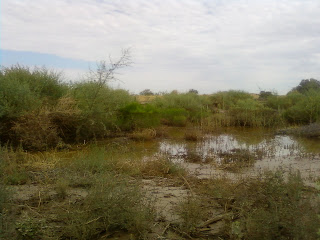Holy Unexpectedly Flooded Field Sites!

Yesterday morning started off as a typical Monday; heading out early to the field. Matt Griffiths and I discussed whether we should water and what to weed, our appreciation for a high in the mid-90s rather than low-100s, and our weekend adventures as we shot up I-10 to our North Simpson Farm habitat restoration field site northwest of Marana. As we approached the site, I watched the roadsides for signs of a good rainfall from the weekend, as most of Tucson experienced. I saw some water pooled in ditches and let my hopes climb that we would not have to water our plants for another week, at least.
We arrived at our storage area, loaded the truck with tools, turned down the road to the site and...the road was closed! The only reason they close this road is for flooding at the bridge that crosses the Santa Cruz River (SCR). Twice in my 5+ year tenure with Tucson Audubon this site has flooded; the summers of 2005 and 2006. After 4 years of poor flooding, the "Road Closed" sign was an extraordinarily welcome sight.
Our efforts at habitat restoration take place on part of this old abandoned farmland along the SCR. Historically, the entire 1700 acre farm was part of the floodplain and would regularly flood during the monsoon. However, since the major floods of 1983 and 1993, large sand berms were built on either side of the river to prevent over-land flow that would impact active farmlands downstream. This effectively shrinks the riparian area because many native riparian plant species rely on flood waters for propagation and survival. So our work in attempting to create some kind of native, bird-loving riparian habitat here is challenging, at best. Most people in the field of restoration agree that restoring natural processes, like hydrology, is key to restoring habitat. However, the Simpson Farm has so many inhibitory factors, like these berms, that contribute to the impossibility of the site returning itself to a natural state that our role as habitat restorationists becomes one of large-scale gardeners, where the goal is to create a garden that requires minimal taxing on resources like groundwater and labor for maximal native vegetation denisty and diversity that may ONE DAY be able to take off on its own in spite of human-constructed blockades and climate change.
I admit, I often hold a lot of doubt in my heart that we will succeed in this goal at the Simpson Farm. We have been through many rainless summers there of late and end up relying on irrigation, even though we know nothing fully supplants rain and river water. Then, all of a sudden, I show up to work one day and hope is restored! The site is soaked from Santa Cruz River water that gathered from high-flows from an Eastside Tucson downpour, was shunted through the channelized washes and river of Tucson, hits the under-sized bridge on the upstream side of our site, jumps the riverbanks, travels down the road past the sandberms and WHOOSH! across our site. This kind of soaking, which was not strong enough to damage irrigation or scour out plants, will soak in the ground and probably keep soil moisture levels high for most of the remaining hot season. Our plants will be able to expand their root sytems for stronger establishment and better weathering of future dry times, without our supplemental efforts.
In conclusion, yesterday was a great day. I have the mud on my boots to prove it. The site flooding was a surprise because I was unaware of the extreme weather events that took place higher up in the watershed, but that made the day all the more enjoyable.  And the best part? The boat we discovered at the Martin Farm, which is one mile upstream from the Simpson Farm, rode the river to Simpson! It appears the SCR is navigable!
And the best part? The boat we discovered at the Martin Farm, which is one mile upstream from the Simpson Farm, rode the river to Simpson! It appears the SCR is navigable!
 And the best part? The boat we discovered at the Martin Farm, which is one mile upstream from the Simpson Farm, rode the river to Simpson! It appears the SCR is navigable!
And the best part? The boat we discovered at the Martin Farm, which is one mile upstream from the Simpson Farm, rode the river to Simpson! It appears the SCR is navigable!
Comments
Post a Comment
Thanks, we value your opinions! Your comment will be reviewed before being published.